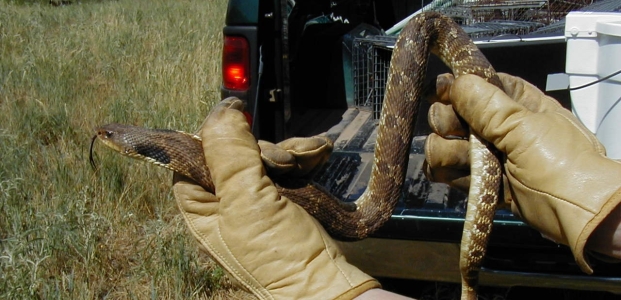Wild Pantex - Nuisance Animals: Wrong Place, Wrong Time
Article by Jim Ray, Pantex Wildlife Biologist/Scientist
I had just got to work, settled in at my desk, read a few e-mails, and then my phone rang. The caller proceeded to tell me they were trying to work, but were interrupted by the presence of a rattlesnake. I strapped on my snake leggings, hopped in my truck and headed out toward the location, which involved a 10-15 minute drive.
Actually, snake calls are not that uncommon at Pantex. After all, we are situated out in the prairie. Most nuisance snake calls involve the prairie rattlesnake, bullsnake or checkered gartersnake. But, sometimes it will be an oddity. For example, the only eastern hognose snake ever documented at Pantex was captured in a building during a similar nuisance animal response.
Upon arrival where the rattlesnake was, several workers helped direct me to the snake, which was coiled in a dark corner of the building. True to form, it was a prairie rattlesnake which is the only rattlesnake species documented at Pantex, or that would even be expected in our habitats. With snake tongs, I safely captured it and placed it in a five gallon bucket. I carefully slid a second bucket down into the first, creating a safe holding container for the snake.
Our nuisance animal management program is guided by the Management Plan for Nuisance Animals at Pantex Plant, which was approved by Pantex’s National Nuclear Security Administration Production Office. So, what makes an animal a nuisance? As regards native animals, our use of the term “nuisance” applies only to situations; in other words, when an animal is impacting work, is in a location that is of cause for concern or is acting in a manner that is a cause of concern. Usually, the animal is fine; it is just in the wrong place at the wrong time.
The rattlesnake, of course, has special considerations because it is venomous. But, had the rattlesnake simply been observed crossing a road out in the backcountry, even it would have been left alone. Meanwhile, the peaceful mourning dove sitting on a nest located on the engine block of an important piece of equipment might be considered a nuisance until the pair successfully fledge their young. Other common nuisance animal situations at Pantex include striped skunks under buildings, the presence of feral cats or stray dogs, feral pigeons nesting over work areas and cottontail rabbit and wood rat damage to vehicle wiring.
When we need outside support with situations, we have a great relationship with the U.S. Department of Agriculture’s Wildlife Services, the Texas Parks and Wildlife Department and the U.S. Fish and Wildlife Service. We hold a permit from the Texas Parks and Wildlife Department to trap and relocate nuisance fur-bearing animals, such as raccoons and opossums.
I just never know what a day may hold in terms of nuisance animal situations. Some days I may be able to focus on research or other “planned tasks,” while other days may find me responding to different nuisance animal calls, including setting traps and moving animals. As for today’s subject rattlesnake, following capture, she was transported to a prairie dog colony a few miles to the west and released unharmed.
Please feel free to share this link with others that enjoy wildlife or that appreciate entities that take great strides to contribute to wildlife conservation.

Photo: This large, although harmless, eastern hognose snake was captured on a nuisance animal response trip and relocated to suitable habitat on Pantex. This individual remains the only one of its kind ever documented at Pantex.
